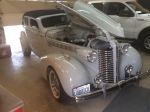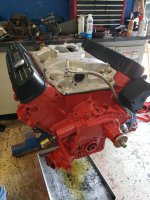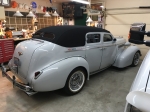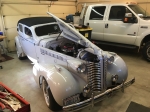I am having overheating issues with my 1938 Buick Century 455 streetrod. Overheat happens on the highway. I am thinking blocking off intake bypass will allow all coolant to pass thru radiator? Any issues With blocking bypass hose? Can I leave thermostat in? Should I drill small holes in thermostat or bypass plug? Trust me this is the last resort…..I have tried everything else except engine oil cooler!
You are using an out of date browser. It may not display this or other websites correctly.
You should upgrade or use an alternative browser.
You should upgrade or use an alternative browser.
Intake by-pass
- Thread starter lobuick
- Start date
I always drill a small hole in a thermostat, to ensure air bleeds out, but not to allow water flow, I think that would not be a good reason. I also don't think you should have to plug the bypass to keep it cool.
You don't have any sign of a problem on a hot day idling around in traffic?
When its getting hot on the highway, have you ever pulled over and check to see if the outlet temperature on the radiator is too hot which could mean inadequate air flow or too small of a radiator (should also have a problem in traffic)?
You don't have any sign of a problem on a hot day idling around in traffic?
When its getting hot on the highway, have you ever pulled over and check to see if the outlet temperature on the radiator is too hot which could mean inadequate air flow or too small of a radiator (should also have a problem in traffic)?
The outlet bottom of radiator is150……outlet top of engine/thermostat 230. That is why I think I am recycling hot engine coolant back thru bypass hose to water pump? The radiator is custom Brice Thomas Radiator with (3) 1-1/2 cores, approximately 17” x 22” with a 7” top tank, Cooling Components shrouded fan, 2500 cfm two speed fan, rubber flaps on bottom of shroud and Dakota digital PAC 2750 fan controller. Total capacity 21-1/2 qts., radiator-11qts., engine 10-1/2qts.
Last edited:
You are recycling warm/hot water through the bypass primarily when the thermostat is closed or restricted. Without it, the engine will develop hot spots. It should not be eliminated.
You could look at your thermostat and make sure there is nothing interfering with its operation. There are performance or heavy duty thermostats offered. They all have the hole or check valve that I mentioned.
The only time it shows a problem is on the highway? Not in traffic?
Are the radiator hoses in good condition, firm and not too old, could there be a restriction in them due to an unseen deterioration?
What is your history with the engine, was it rebuilt? Should you do a good block flush, and if you did one, what did you find, was it clean or show signs of filth? Engines that run straight water without a rust preventative, for even a short period of time, can have significant rust build up insulating the heat transfer process.
You probably shouldn't need it, but they do offer heavy duty water pumps that move a little more water.
Hope that helps, I'm just trying to ask a question that may lead to a problem solve
You could look at your thermostat and make sure there is nothing interfering with its operation. There are performance or heavy duty thermostats offered. They all have the hole or check valve that I mentioned.
The only time it shows a problem is on the highway? Not in traffic?
Are the radiator hoses in good condition, firm and not too old, could there be a restriction in them due to an unseen deterioration?
What is your history with the engine, was it rebuilt? Should you do a good block flush, and if you did one, what did you find, was it clean or show signs of filth? Engines that run straight water without a rust preventative, for even a short period of time, can have significant rust build up insulating the heat transfer process.
You probably shouldn't need it, but they do offer heavy duty water pumps that move a little more water.
Hope that helps, I'm just trying to ask a question that may lead to a problem solve
I have seen lower hoses collapse on themselves with the suction of the water pump. Some have springs inside to prevent this condition. In a specialty application it is a direction to look?
An engine that runs hot crising down the highway can be numerous things. Rad seems to be doing it's job via 230* inlet at top & 150* outlet at bottom. As stated check for a spring in the lower hose. Doesn't sound like an air flow problem although you really can't check inlet & outlet temps. while cruising down the highway.
What engine/trans. are you using. Too little timing, retarded, cruising down the highway can cause running hot issues. As well as too much timing, but then again you would probably be pinging or detonating itself to death which I'm sure you will hear or fell.
Tom T.
What engine/trans. are you using. Too little timing, retarded, cruising down the highway can cause running hot issues. As well as too much timing, but then again you would probably be pinging or detonating itself to death which I'm sure you will hear or fell.
Tom T.
Thanx fellas for the ideas. My current plan is to block the by-pass hose with a 3/16” air bleed hole, eliminate thermostat and use a NASCAR type restrictor plate with a 5/8” hole. The engine is a fresh rebuild, 1976 short block, 9.5 comp., 1970 heads, TA 112 cam, Eldelbrock performer manifold, 1970 Q-jet, Custom Brice Thomas radiator, (3) 1 1/2” cores, 7” top tank, Cooling Components 2500cfm shrouded fan w/rubber flaps on the bottom, solid flex tubing upper & lower radiator hoses, Dakota digital two speed fan controller. My next option is relocate oil filter and add engine oil cooler w/fan. The car is a 1938 Buick street rod
Attachments
I think it would be a good idea if you can figure out how to get the temperature while on the highway it would get a good confirmation that the radiator is either doing its job or not. If you can switch the fan on and off manually, that might be a good experiment while on the highway.
suntreemcanic
Experienced Member
Good lookin '38. I like that look of the running board removal and combination whitewall/gold stripe/spoke wheel.
Hi, I’m just reading this for the first time, & don’t know if you’ve solved the problem yet,
But at highway speeds could it be a back-pressure problem where (at higher speed) air rushing into the engine-bay from under the car is having a reverse pressure effect, & reducing airflow through the radiator, (like blowing air back through the other side of the radiator & having a counter effect ? I’ve heard of this happening because of certain shaped front clips or engine-bay shapes; & by making up ‘air directing or reducing’ panels under the engine-bay (or in certain places) to direct all air to flow through the radiator & out of the engine-bay through the side hood covers & under the rear of the engine-bay to achieve good flow-through; worth a thought, cool car, good luck
But at highway speeds could it be a back-pressure problem where (at higher speed) air rushing into the engine-bay from under the car is having a reverse pressure effect, & reducing airflow through the radiator, (like blowing air back through the other side of the radiator & having a counter effect ? I’ve heard of this happening because of certain shaped front clips or engine-bay shapes; & by making up ‘air directing or reducing’ panels under the engine-bay (or in certain places) to direct all air to flow through the radiator & out of the engine-bay through the side hood covers & under the rear of the engine-bay to achieve good flow-through; worth a thought, cool car, good luck
Johnny Puuma
Newbie
I had a problem with the temperature when I cruising in traffic with a very low speed and take off the thermostat, problem was solved at low speed, but then the problem move to high speed cruise, without thermostat water don’t flow into back of the engine and boil the water.Thanx fellas for the ideas. My current plan is to block the by-pass hose with a 3/16” air bleed hole, eliminate thermostat and use a NASCAR type restrictor plate with a 5/8” hole. The engine is a fresh rebuild, 1976 short block, 9.5 comp., 1970 heads, TA 112 cam, Eldelbrock performer manifold, 1970 Q-jet, Custom Brice Thomas radiator, (3) 1 1/2” cores, 7” top tank, Cooling Components 2500cfm shrouded fan w/rubber flaps on the bottom, solid flex tubing upper & lower radiator hoses, Dakota digital two speed fan controller. My next option is relocate oil filter and add engine oil cooler w/fan. The car is a 1938 Buick street rod
A problem heating up at cruise is a classic symptom of "insufficient radiator". You cannot clean a brass/copper radiator once they get deposits in them. You can have the radiator recored, or replace it entirely. Removing the thermostat delays the warm up of the engine, but will not solve a cooling problem caused by other factors. Also, ignition timing is very important. Your vacuum advance should be connected and WORKING. Cruise timing should be around 40*. Retarded timing will cause an engine to run hot.I had a problem with the temperature when I cruising in traffic with a very low speed and take off the thermostat, problem was solved at low speed, but then the problem move to high speed cruise, without thermostat water don’t flow into back of the engine and boil the water.






